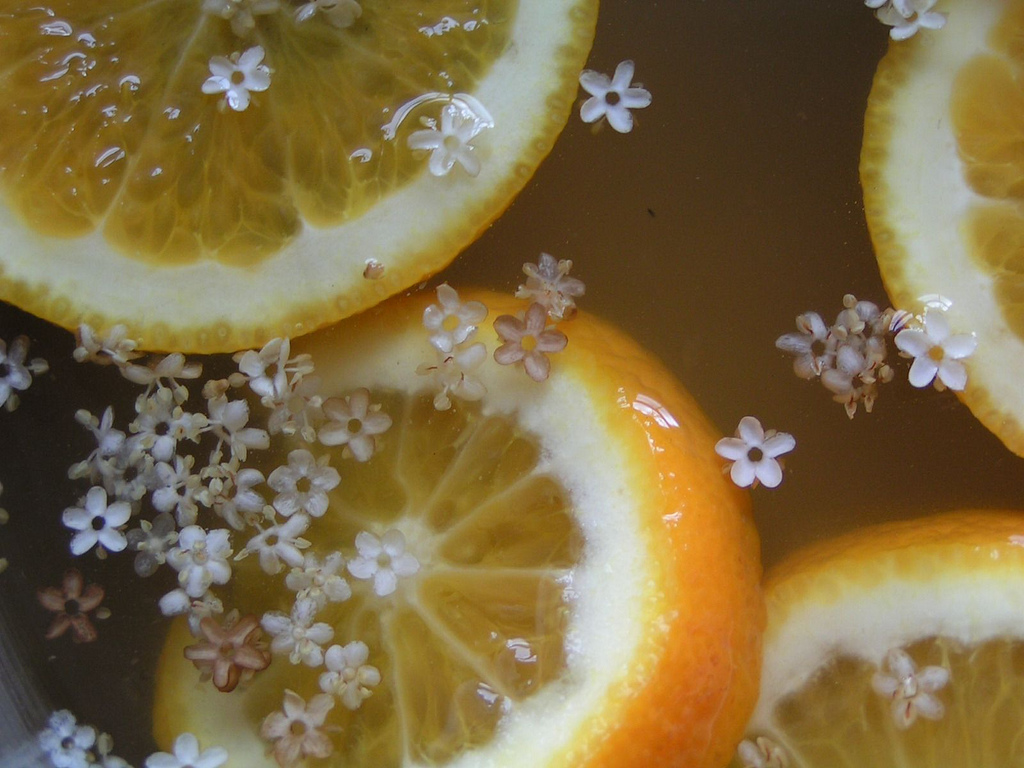
The Elder has earned its name. Through centuries of healing, the Elder has always come through. Some call her Mother. Others call her Lady Ellhorn. The scientific name, Sambucus, hearkens back to the Ancient Greek word for a strange harp-like instrument.
In the most northeastern corner of Ohio, the Elder flowers are just beginning to open exuding their unusual fragrance. The flowers and berries are edible and medicinal, in fact the entire plant is medicinal. Though beware the cyanogenic glycosides; they are broken down into cyanide in the body, which in small doses is quite anti-inflammatory.
But if you try an elderberry smoothie you might learn the meaning of emetic. To prevent such an event, I’ll share a number of amusing similes: upchuck, barf, puke, heave, regurgitate, retch, spew, toss your cookies, do the technicolor yawn.
When I was studying at the Elderberry School of Botanical Medicine, such an event nearly occurred. Luckily for the student that made such a smoothie, her friends experienced mal de mer, biliousness, aka nausea, not the technicolor yawn.
Elder berries should be cooked to break down the cyanogenic glycosides. But that said, make sure you are using black or blue Elder berries or Elder flowers. The red Elder is much higher in these chemicals and should be avoided. Here’s how you tell the difference.

This photo above is red Elder. Note the flowers are collected around the stalk. In botanical terms, this is referred to as a racemose inflorescence, or a raceme. The red Elder scientific name is Sambucus racemosa, meaning the Elder with the raceme.

The photo here is of black Elder, also called Sambucus nigra. Note that the stalk splits and creates an inflorescence that is called an umbel. Note that the shape is more like an umbrella.

This is a blue Elder, called Sambucus mexicana. Also safe to use, though like all Elders, the berries should be cooked.

And one last warning. The photo above is Arrowwood, aka Viburnum dentatum. Not Elder. Note the leaves and compare to the Elders. Don’t mix these up. Although some of the berries of Viburnums are edible, some are toxic depending on the species. Although there are a few obscure mentions of medicinal uses, this particular Viburnum was mostly used for making arrows.
Besides the scientific reason to respect Elder, there are many folktales and strange medicinal habits that people have performed over the centuries, which I’ll share in my A Year of Trees course. For instance, falling asleep under an Elder might cause you to sleep for hundreds of years transporting you to another time. Or perhaps you’ll be kidnapped by the Fey Folk. But for now, let’s just enjoy a nice safe recipe.

Easy Elder Flower Cordial
Fill a jar 3/4 full with elder flowers and citrus slices. I like lemon or orange, but you could use grapefruit or lime. You can also omit the citrus and try something like strawberry. I usually pack it down a bit, but not too much. Then cover the flowers with honey or maple syrup… or even just plain old sugar; though I would opt for organic raw cane sugar, or even a nice quality brown sugar. You can add more flowers if you are using a dry sugar rather than honey or maple syrup.
I usually turn the jar over twice a day, sometimes shaking, sometimes not. Watch the lid to see if pressure builds up. If it does, loosen the lid to release the pressure, then tighten the lid again. After a week or so, the juices from the elder flowers will exude creating a syrupy consistency. Then strain the syrup and refrigerate. Use within a month.
To make a cordial, add to sparkling water. Or pour the syrup over anything you like syrup on, use as a sweetener for iced or hot tea, or as a flavor in a cocktail.
In larger doses, this syrup could be added to hot medicinal teas to reduce fever and loosen congestion. Try adding to chamomile or catnip tea.
